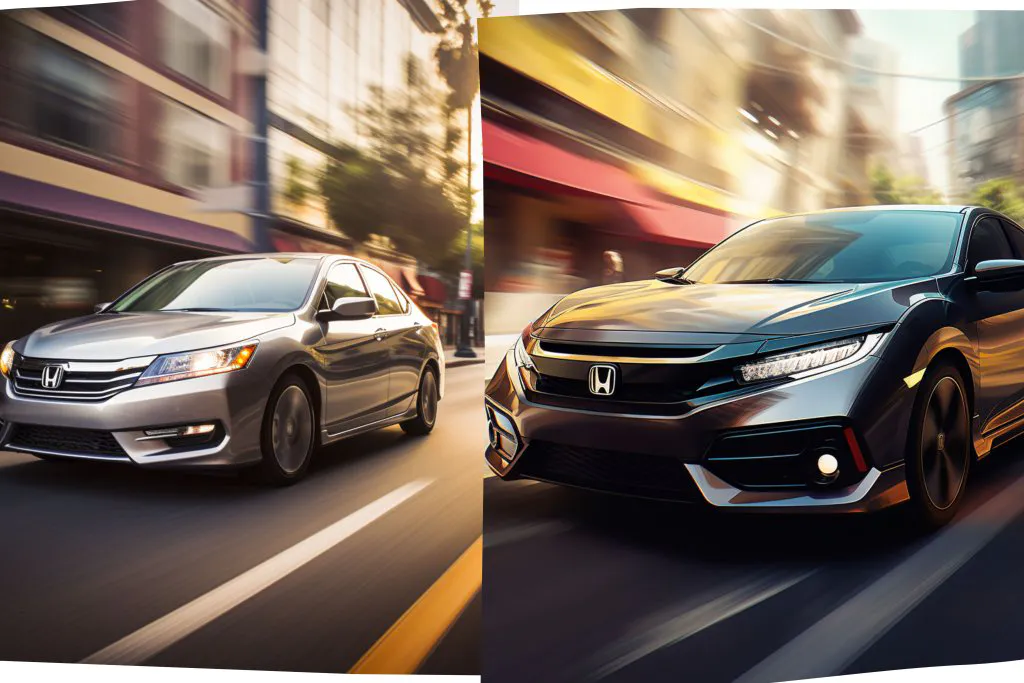Sedans and wagons were once a dominant feature on American roads, accounting for 80% of the market 50 years ago, according to the federal government. This share fell to 50% in 2013 and is about 25% today. Despite the shift to crossovers, SUVs, and pickups, sales of sedans are still alive and well, at least for Asian brands like Honda.
In 2022, the automaker sold over 150,000 Accords and almost 144,000 Civics, reports carfigures.com. These are significant numbers for any manufacturer. So, Honda consciously tries to keep its sedans appealing and contemporary. As a result, Honda fans may face challenges when choosing between the Accord and the Civic. This applies equally to second-hand models. Popular new cars make for in-demand used ones.
While shoppers may have ruled out a Toyota Camry, Toyota Corolla, Nissan Altima, or Nissan Altima, there’s more to choosing a Honda Accord or Honda Civic than flipping a coin. Having owned several Accords over the years and spending significant time in and around Civics, I can tell you these cars are very different, even if they wear the same badge.
To make the process easier, I’ve put together an extensive guide that compares the Honda Accord and Honda Civic. This review covers 2023 models and used editions since 2001. You’ll get the full specs on equipment, reliability, market value, safety, and fuel economy. It’s everything you need to make an informed decision. Further, FIXD surveys from Accord and Civic owners offer additional insights into these vehicles.
Not only will you learn what separates these Hondas (there are similarities, too), but you’ll discover what model years to avoid. For instance, most older Civics have engine reliability issues, and the Accord has its share of these problem years.
Keep reading to see how this Honda Accord versus Honda Civic contest turns out. Other match-ups to review include Outback vs. Forester, RAV4 vs. CR-V, Civic vs. Corolla, Pilot vs. Highlander, and Odyssey vs. Sienna.
| Income Bracket | Monthly Financing Cost Range | Cash Purchase Price Range | Honda Civic Years | Honda Accord Years | Best Model Year: | Why? |
| $5k-$10k | $83-$125 | $3,000-$4,500 | 2006 | 2005 | 2006 Civic | Strong safety score, reasonable engine reliability, and modest market value |
| $10k-$15k | $125-$187 | $4,500-$6,750 | 2010 | 2011 | 2011 Accord | Above-average engine reliability, strong safety score |
| $15k-$25k | $187-$312 | $6,750-$11,250 | 2015 | N/A | 2015 Civic | Above-average engine reliability, modest market value |
| $25k-$35k | $312-$437 | $11,250-$15,750 | 2017 | N/A | 2017 Civic | Good engine reliability, perfect safety score |
| $35k-$50k | $437-$625 | $15,750-$22,500 | 2019 | 2019 | 2019 Accord | Perfect engine reliability and safety scores |
| $50k-$74k | $625-$925 | $22,500-$33,300 | N/A | 2021 | 2021 Accord | Perfect engine reliability |
See the methodology for the table above.
Before you respond to the “For Sale” ad, check out this How to Buy a Used Car article for a step-by-step checklist.
Price History Comparison | Honda Accord vs. Honda Civic
Average Market Value – Based on Owners’ Self-Reported Mileages | Honda Accord vs. Honda Civic
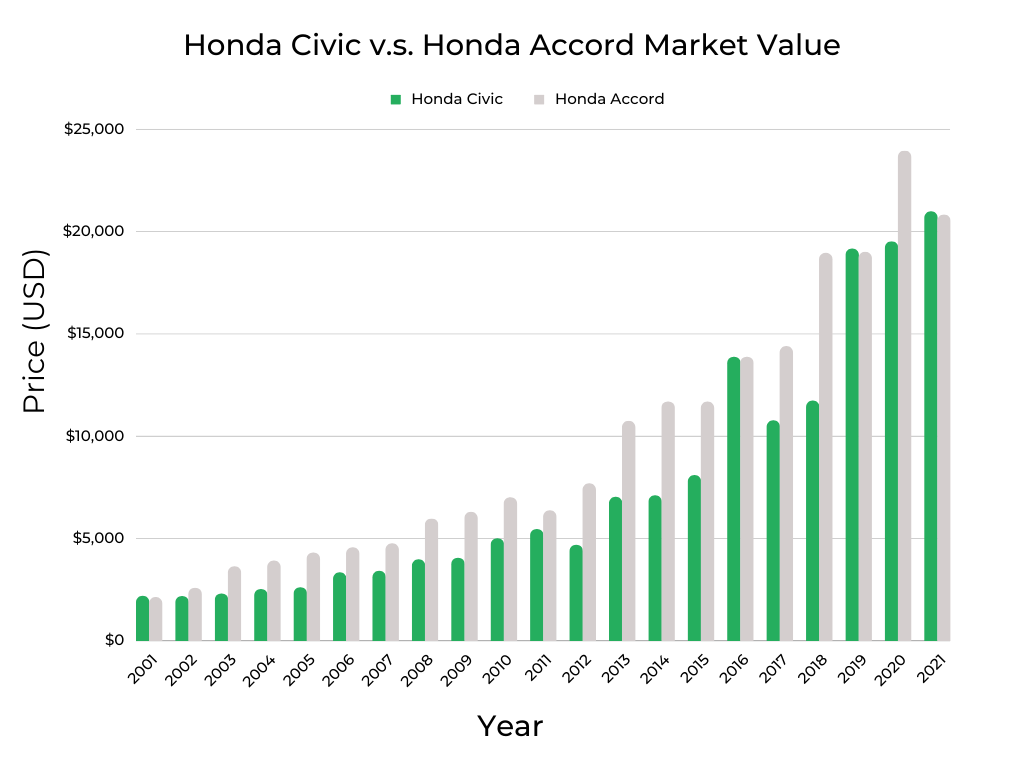
A vehicle’s price is a major determining factor for most car buyers. The graphic shows Kelley Blue Book (KBB) market values for the Accord (gray) and Civic (green). You’ll see that, except for a few model years (which I explain below), both Hondas show a steady increase in value with each more recent model year. This is how things should be, as newer cars are worth more.
I’ll point out that this KBB information is based on private-party transactions, which are about one-third to one-half less than buying from a dealer. One way to offset this difference (if you’re going the retail route) is to shop for an older model or one with less equipment or higher mileage.
Some of the fluctuations in the above values are due to the Accord costing more than the Civic (assuming the same model year and comparable equipment). But mileage also impacts these numbers for the Accord and Civic. Higher digits on the odometer drag down a car’s value, and less mileage boosts a car’s worth. That’s why the 2001, 2016, 2019, and 2021 model years show near-identical valuations. Either the higher-cost Accord had high mileage, or the less-expensive Civic had less mileage. These mileage figures are based on FIXD owner surveys.
Similarly, the value of the 2018 Accord towers over the 2018 Civic. The survey data for 2018 shows that the average Accord owner had 25,000 miles on the clock, while the typical Civic owner logged over 45,000 miles. Hence, the difference in valuations.
So, outside of the effects of mileage, condition, and equipment, it’s safe to assume that an Accord will always cost more than a Civic from the same year. However, looking for a high-mileage Accord means you might be able to afford a larger Honda while on a Civic budget.
Be sure to read our Best and Worst Years series of articles highlighting the Honda Accord and Honda Civic winners and losers.
Depreciation vs. Maintenance Expenses
Depreciation hits new cars with a wallop. During the first year, it’s not unusual for a new vehicle to lose 10%-15% of its value. After five years, depreciation can cut a car’s value in half. Even automobiles that tend to suffer less from this effect, like Hondas, can’t escape the issue. Value-focused used car buyers bypass most depreciation concerns by looking for models with at least ten years of history on the road. Value loss quiets down at this point.
Yet a vehicle’s age is only part of the magic formula for savvy car buying. The cost of repairs and maintenance is also an important consideration. This translates into the 2004-2008 being the “sweet spot” model years for the Accord (the black-outlined box). Yet, the window for a good blend of depreciation and upkeep costs is much larger for the Civic. Here, you’ll find 2002-2011 editions, potentially ideal opportunities.
Later, I’ll get into more detail about repair and maintenance expenses for the Accord and Civic, explaining why there are more buying options with the smaller Honda. Also, pay attention to the best and worst year options, highlighted toward the end of this article.
But don’t assume every example within these ranges is a smart buy. Learn more by reviewing the best and worst years of the Honda Accord and Honda Civic. There’s also an at–a–glance summary towards the end of this article.
Reliability Comparison | Honda Accord vs. Honda Civic
Two ratings are at the core of our look at the Honda Accord and Honda Civic.
- The FIXD Reliability Score measures the number of check engine lights recorded for a particular model year by installed FIXD sensors. Think of it as an engine reliability score. While every check engine light doesn’t directly translate into reliability concerns (such as a dead battery or loose gas cap), these indicators still provide insight into a car’s dependability. This data is weighted by mileage.
- The second rating is the Owner Reliability Score. This is a subjective ranking of how surveyed owners feel about their respective vehicle’s dependability. Each owner estimates how capable their car is for trips of different lengths. A vehicle that can handle a cross-country adventure receives the highest score, while a car only suitable for a quick point A to point B trip gets the lowest score.
Both rankings are based on 1 being the lowest, 10 being the highest, and 5 being the average score.
We’ll also point out that both scores seldom align. The FIXD Reliability Score is determined by a definitive number, the frequency of check engine lights. On the other hand, the Owner Reliability Score is opinion-based. Owners tend to have pride in their automobiles, with higher ratings as a result. At a minimum, those with older vehicles are more accepting of check engine lights. For many, it’s the price of owning an aging car.
Although the Accord tops the Civic for 11 out of 21 years of FIXD Reliability Scores, both cars have somewhat similar score ranges for most of these years. Only with some of the older years (2003-2005) and more recent examples (2011, 2017, and 2019) is the Accord noticeably more reliable (regarding the engine).
That said, there are five years where the Civic’s engine proves more dependable and five years where both Honda have a tied FIXD Reliability Score.
Another way to look at this is that the Accord’s engine has better reliability 52.3% of the time, compared to 23.8% for the Civic.
To be fair, an expensive repair bill doesn’t always accompany a check engine light (CEL). Sometimes, all it takes is an ill-fitting gas cap or a loose wire to trigger a dashboard warning light. That said, the Civic’s bottom-of-the-barrel FIXD Reliability Score (1 out of 10) for the oldest model years (2001-2005) is especially striking, and not in a good way.
Yet, check engine lights aren’t a turn-off for Accord and Civic owners, according to Owner Reliability Scores. In particular, owners of those older Civics (2001-20015) aren’t crushed by CEL frequency. Overall, these Honda owners think favorably of their cars. However, car owners tend to be biased about their rides.
Review the Best and Worst Years articles on the Honda Accord and Honda Civic to learn more about these vehicles’ FIXD Reliability and Owner Reliability Scores.
Longevity Comparison | Honda Accord vs. Honda Civic
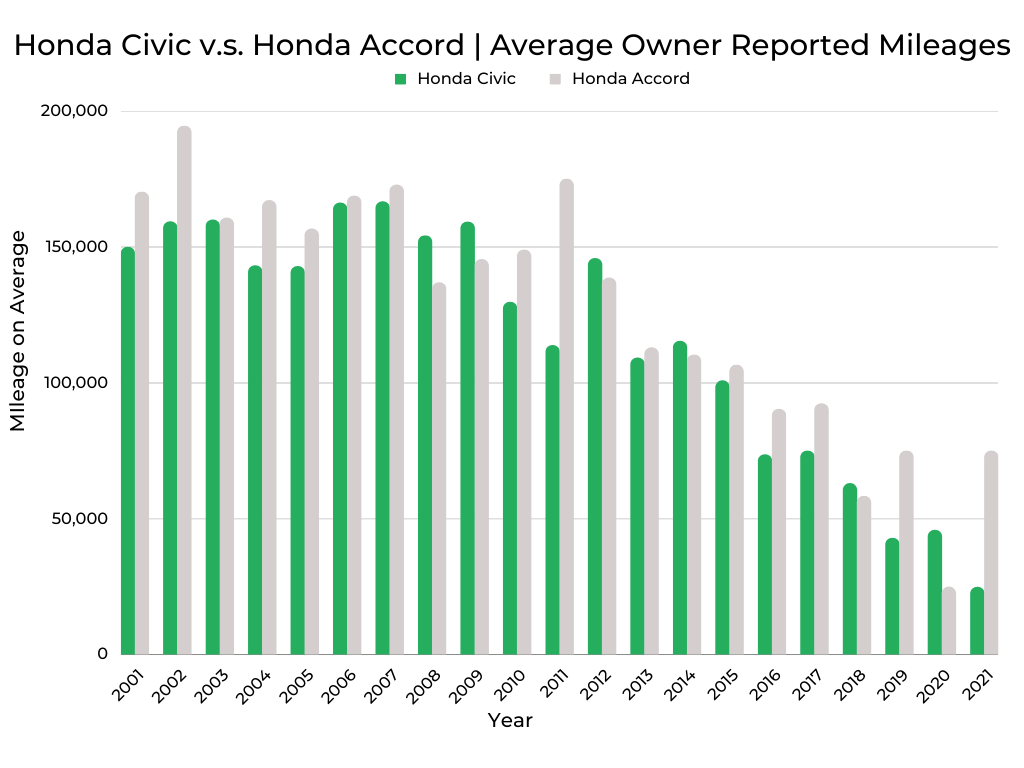
Owner-reported mileage via FIXD surveys shows similar usage for the Accord and the Civic. Yes, there are a few years (2002, 2011, and 2021) where the Accord racks up more miles, but this isn’t unusual; no two cars are used the same.
However, this data helps predict the lifespan of these Hondas. The Accord and Civic can reach 150,000. But is greater usability possible?
I’ll take an unscientific approach to find out by examining nationwide for-sale listings on autotrader.com (November 7, 2023). The search revealed 14,095 Accords and 14,622 Civics (from the 2001-2021 model years) available for purchase.
Here’s where it gets interesting. Among these listings, 367 Accords (2.6%) had 200,000 miles or more, while the numbers stood at 202 for the Civic or 1.3%. This tells me that while owning a high-mileage Accord or Civic is possible, it’s not an everyday occurrence. Further, Accords are twice as likely to cross the 200,000-mile threshold than the Civic.
I’ll also mention that regular maintenance and accident-free driving significantly contribute to a vehicle’s longevity. Build quality takes a car only so far; the rest is up to the owner.
Review the individual articles on the best and worst years of the Honda Accord and Honda Civic for a more thorough look at longevity.
2023 Honda Accord vs. Honda Civic | A Guide to Trim Levels & Optional Features
Trim Levels: Starting Prices
Let’s shift the conversation to new Hondas. The Accord and Civic occupy different places in the Honda lineup. So, seeing a substantial price separation between the two vehicles is unsurprising. The price for entry with the Accord starts at $27,295 for the base LX trim, while the equivalent Civic (also the LX) goes for $23,750, or a difference of $3,545.
Stepping up to an Accord LX from a Civic LX means spending a 15% premium or any extra $70 per month via a typical five-year loan at 7.5% interest. Is the extra space and more powerful engine worth it? That’s a question only the buyer can answer.
For several reasons, the query becomes even more challenging as you move up the trim level. For one, two-thirds of the Accord trims are based around a hybrid engine, something that’s not an option for the 2023 Civic. Further, the Civic is available as a sedan or five-door hatchback, while the 2023 Accord is sedan only.
There is also the sheer number of trims, with six options for the Accord and ten for the Civic. Not only do most Accord and Civic editions not align, but the body style and engine variations create apples-to-oranges comparisons. Add in that the Civic is available in two performance variants, the spunky Si and the smile-inducing Type R, and comparing pricing for these two Hondas is even less clear.
The closest up-range pairing will be the Accord EX at $29,060 and the Civic Sedan EX at $26,200, a difference of $2,860 (or 11% above the Civic). I’ll put the engine bay aside to see how the top-tier Accord Touring Hybrid stacks up against the Civic Sedan Touring. The larger Honda stickers at $37,325, while the loaded Civic sells for $30,350, a gap of $6,975. Buying the king-of-the-hill Accord means spending 23% more over the almost equivalent Civic. At least you’d get a hybrid engine out of the deal and a substantial boost in fuel economy (which I’ll cover later).
| 2023 Honda Accord Model | Starting Price |
| LX | $27,295 |
| EX | $29,060 |
| Sport Hybrid | $31,345 |
| EX-L Hybrid | $32,990 |
| Sport-L Hybrid | $33,325 |
| Touring Hybrid | $37,340 |
| 2023 Honda Civic Model | Starting Price |
| Sedan LX | $23,750 |
| Sedan Sport | $25,350 |
| Sedan EX | $26,200 |
| Sedan Touring | $30,350 |
| Hatchback LX | $24,750 |
| Hatchback Sport | $26,150 |
| Hatchback EX-L | $27,900 |
| Hatchback Sport Touring | $31,250 |
| Si Sedan | $28,000 |
| Type R | $43,795 |
2023 | Honda Accord vs. Honda Civic | Specifications | Safety, Interior, and Exterior Features
Sizing up the Honda Accord and Honda Civic involves a look at each vehicle’s specifications. Here’s what you need to know.
Vehicle Class & Body Style:
Honda shoppers might be surprised to learn that the U.S. Environmental Protection Agency (EPA) classifies the Accord and Civic as mid-size sedans. While both vehicles have increased in size over the years, successive Civic generations, in particular, have grown larger in interior space. The EPA’s categorization is based on cabin passenger volume and cargo space. Here, we see that there’s not much separation between the two vehicles in terms of interior room.
Inside, the Accord offers 102.8-105-7 cubic feet (depending on the trim) versus 96.6-99.0 cubic feet for the Civic (sedan or hatchback). So, while the Accord is larger, it’s not significantly more spacious than the Civic. Yet, the extra room does affect some interior measurements, which I’ll review later.
| 2023 Honda Accord | 2023 Honda Civic | |
| Class | Mid-Size Sedan | Mid-Size Sedan |
| 4-Door Sedan | LX, EX, Sport Hybrid, EX-L Hybrid, Sport-L Hybrid, Touring Hybrid |
LX, Sport, EX, Touring, Si Sedan, Type R |
| 5-Door Hatchback | LX, Sport, EX-L, Sport Touring |
Powertrain:
Engine Options & Specifications:
Although the Accord and Civic share basic engine architecture, each vehicle takes a different approach to what’s under the hood.
The base engine for the Accord is a turbocharged 1.5-liter four-cylinder engine making 192 horsepower. These Hondas won’t win any stoplight races, but a 0-60 MPH time of 7.2 seconds should meet most people’s needs. A combined fuel economy rating of 32 MPG is respectable for a spacious five-seater.
Meanwhile, the Accord Hybrid relies on a non-turbo 2.0-liter four-cylinder unit paired with a hybrid system. Output gets dialed up to 204 horsepower, and acceleration improves to 0-60 in 6.6 seconds. The 0.6-second improvement may not seem like much, but you’ll notice it behind the wheel. What will truly capture your attention is the significant improvement in fuel economy. The Accord Hybrid is EPA-rated for 44-48 MPG (combined, varies by trim). That’s as much as 50% better than the non-hybrid.
Honda flips the script with the Civic’s engine options. A 158-horsepower 2.0-liter (non-turbo, non-hybrid) four-cylinder engine handles the duties for the lower trims, while the turbo 1.5-liter unit sits under the hood for most higher-end versions. However, the output is tuned down to 180 horsepower, helping create a separation between the Civic and Accord (and justification for the Accord’s higher price).
Expectedly, the Civic is slower off the line, but its lesser weight and reduced horsepower help at the pump. The base 2.0-liter engine requires 8.8 seconds to reach 60 MPH; calling it “pokey” is being polite. However, a combined fuel economy of 33-35 MPG will undoubtedly please owners.
At the same time, the upgraded powerplant (the turbo 1.5-liter engine) propels the Civic to 60 MPH in 7.5 seconds, a noticeable improvement. But performance doesn’t impact gas use as combined fuel economy ranges from 33-36 MPG.
Honda stretches the turbo 1.5-liter to 200 horsepower in the zippy Civic Si Sedan. The company adds a turbocharger and applies other engineering magic to give the non-hybrid 2.0-liter engine 315 horsepower in the neck-snapping Civic Type R (it can hit 60 MPG in 4.9 seconds).
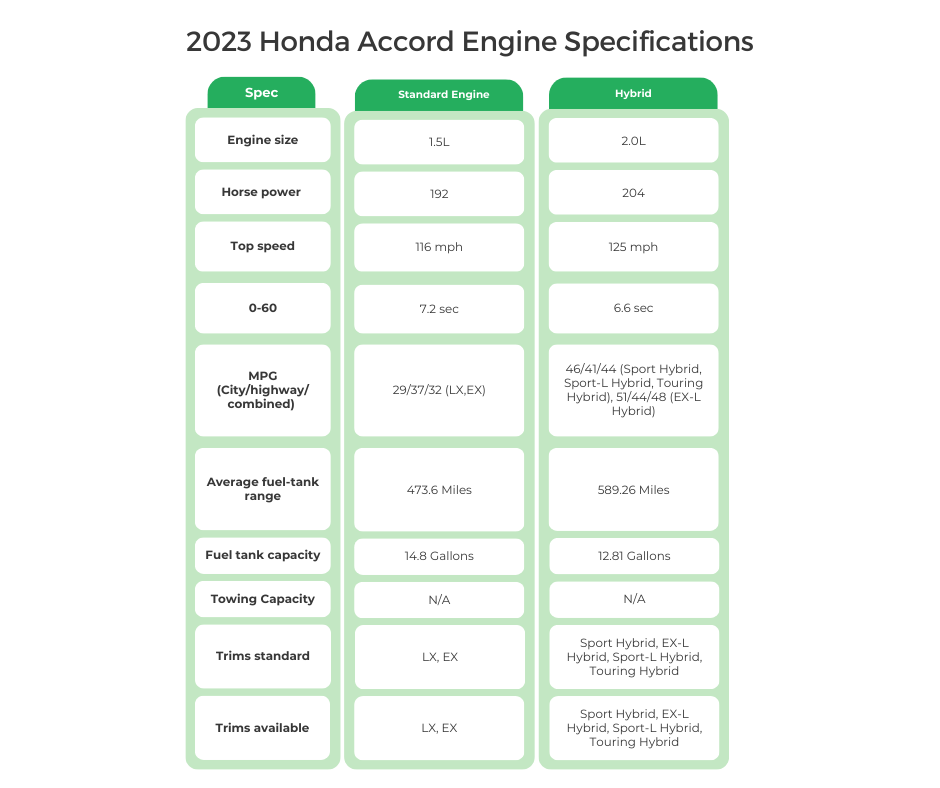
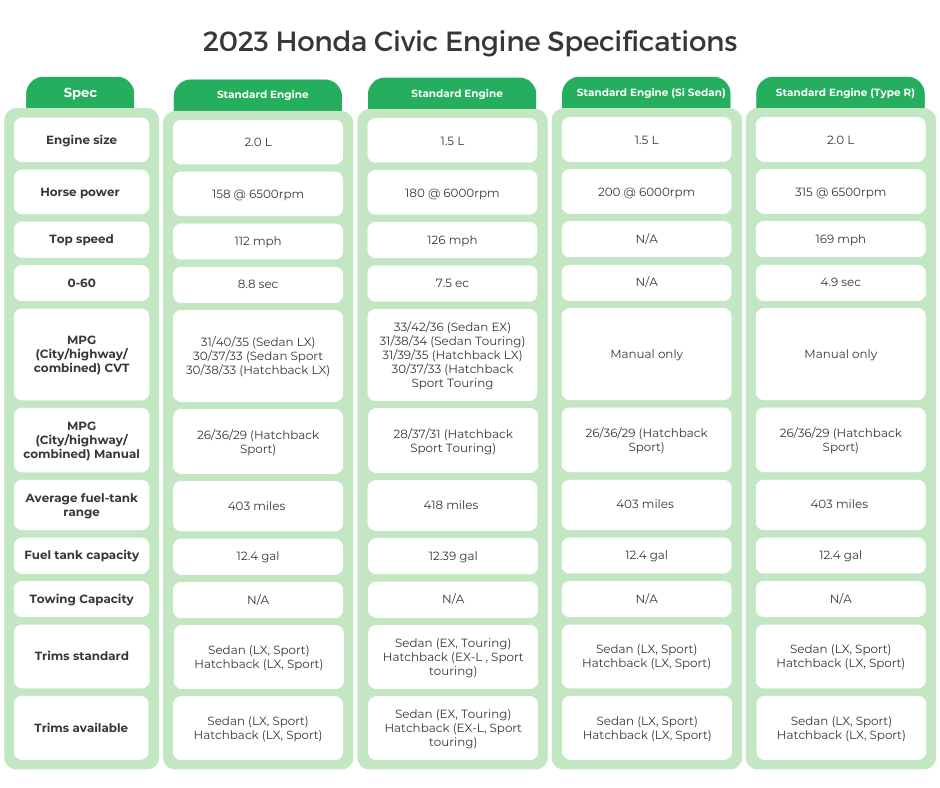
Transmission Options & Specifications:
There’s some transmission sharing between the Accord and Civic. Non-hybrid Accords and most Civic trims use a continuously variable transmission (CVT). A CVT is a self-shifting gearbox that skips conventional gears, favoring a high-tech approach to maximize fuel economy and performance. The Accord Hybrid uses an eCVT. See the “Tech Talk” section below the charts to learn about CVTs and eCVTs.
Opposite these advanced transmissions is a six-speed manual transmission, keeping purists happy. This three-pedal setup is the sole gearbox for the Civic Si Sedan and Type R and the base transmission for the Civic Hatchback Sport and Sport Touring (a CVT is optional).


TECH TALK: CVTs
A continuously variable transmission (CVT) does not use gears like a typical automatic transmission. Instead, it has two pulleys connected by a belt. One pulley connects to the engine, and the other connects to the wheels. The belt transfers the power between the pulleys. This setup allows the pulleys to continuously change positions as needed. The CVT automatically adjusts the pulleys as required, providing smooth and efficient power delivery.
An electronic continuously variable transmission (eCVT) uses electronic controls and electric motors to vary gear ratios instead of a belt and pulley system. Unlike a regular CVT, an eCVT has no physical pulleys or belts—the gear ratio is adjusted seamlessly by controlling the speeds of electric motors and generators. This electronic control allows faster, smoother gear ratio changes compared to a traditional CVT. An eCVT also provides more flexibility, needing less space and having fewer moving parts.
Drivetrain:
There’s not much to discuss with the Accord and Civic drivetrain. No matter the body style or trim, all versions are front-wheel drive.
| 2023 Honda Accord Wheel Drive | FWD | AWD | RWD |
| LX | S | ||
| EX | S | ||
| Sport Hybrid | S | ||
| EX-L Hybrid | S | ||
| Sport-L Hybrid | S | ||
| Touring Hybrid | S |
| 2023 Honda Civic Standard | FWD | AWD | RWD |
| Sedan LX | S | ||
| Sedan Sport | S | ||
| Sedan EX | S | ||
| Sedan Touring | S | ||
| Hatchback LX | S | ||
| Hatchback Sport | S | ||
| Hatchback EX-L | S | ||
| Hatchback Sport Touring | S | ||
| Si Sedan | S | ||
| Type R | S |
Safety:
NHTSA Safety Ratings
FIXD survey data indicates that Accord and Civic owners spend significant time behind the wheel. 42% of those with an Accord in the driveway use their cars for commuting and long-distance driving (called “lots of driving” in the survey). At the same time, 52% use their Accords for family transportation. Civic owners are active as well. 60% use their cars for lots of driving, and 32% haul their loved ones around.
The usage of these Hondas reinforces the importance of safety. Honda understands this and incorporates these requirements into its engineering. However, we’ll have to wait for the 2024 model year to see how the Accord does in National Highway Traffic Safety Administration (NHTSA) testing. 2023 is the first year of the 11th generation and wasn’t assessed. This is common with debuts of an all-new or new-generation vehicle.
On the other hand, the eleventh-generation Civic hit the streets for the 2022 model year, and NHTSA testing was conducted for the 2023 edition. Overall, the Civic (both body styles) and the Si Sedan received a stellar 5 out of 5. The results for side impact and rollover assessments are also perfect. However, frontal crash testing takes a slight step back, with these Civics receiving a still respectable 4 (out of 5).

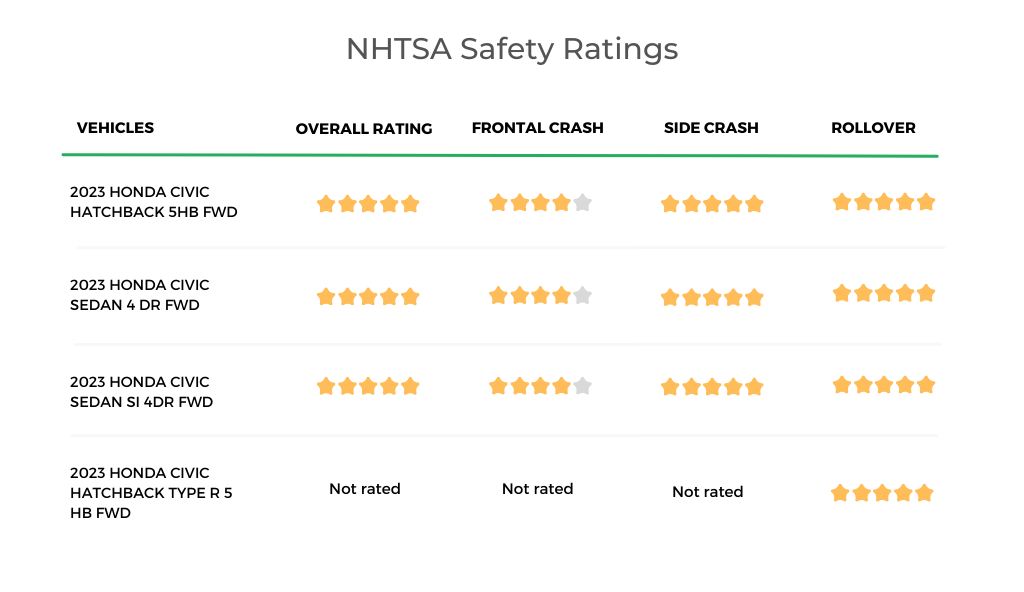
IIHS Awards:
The Insurance Institute for Highway Safety (IIHS) takes a somewhat different approach to safety testing. In particular, it focuses on its small frontal overlap crash test, which the organization feels represents a more real-world scenario (a single car running into a fixed object). IIHS also looks at side impact crashes, roof strength, headlight effectiveness, and advanced driver safety technologies (like automatic emergency braking).
While tested vehicles receive a Good, Acceptable, Marginal, or Poor grade, the true measure comes if a car gets a Top Safety Pick or Top Safety Pick+ designation. If “Good” is a “B” grade, Top Safety Pick notches things up to an “A-,” and the Top Safety Pick+ signifies an “A+.”
While there’s nothing wrong with the Civic’s Top Safety Pick designation, the Accord comes out ahead with a Top Safety Pick+ award.
| IIHS Award | Tested Vehicle | ||
| 2023 Honda Accord | MidSIZE CAR / 4-DOOR SEDAN |
2023 TOP SAFETY PICK + |
2023 Honda Accord EX 4-door |
| 2023 Honda Civic | SMALL CAR / 4-DOOR SEDAN |
2023 TOP SAFETY PICK |
2022 Honda Civic 1.5T Touring 4-door |
| SMALL CAR / 4-DOOR HATCHBACK |
2023 TOP SAFETY PICK |
2022 Honda Civic 1.5T Touring 4-door |
|
Airbags & Head Restraints:
Although the Accord and Civic occupy different places in Honda’s lineup, it’s no surprise that both vehicles have identical airbag equipment. In addition to the usual setup (front-row airbags and side curtain airbags that protect both rows), Honda gives both front-row passengers a knee airbag. These devices help position the body during an accident to minimize injury.
Neither the Accord nor the Civic comes with overhead airbags. This newer technology replaces traditional front-row units (steering wheel and dashboard) with overhead devices. Active head restraints are usually found in specialty and high-end vehicles to minimize whiplash injuries. Mainstream cars like the Accord and Civic aren’t usually equipped with this feature.
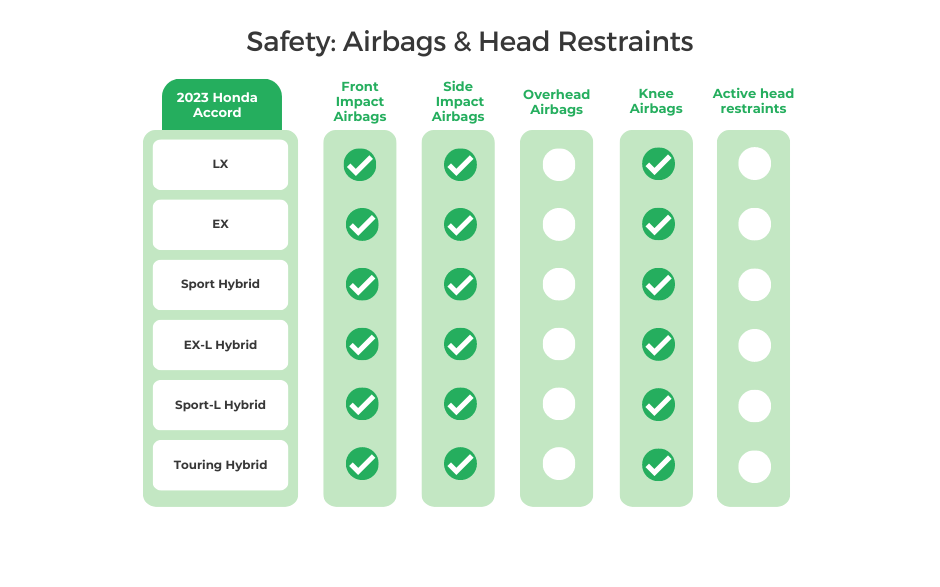
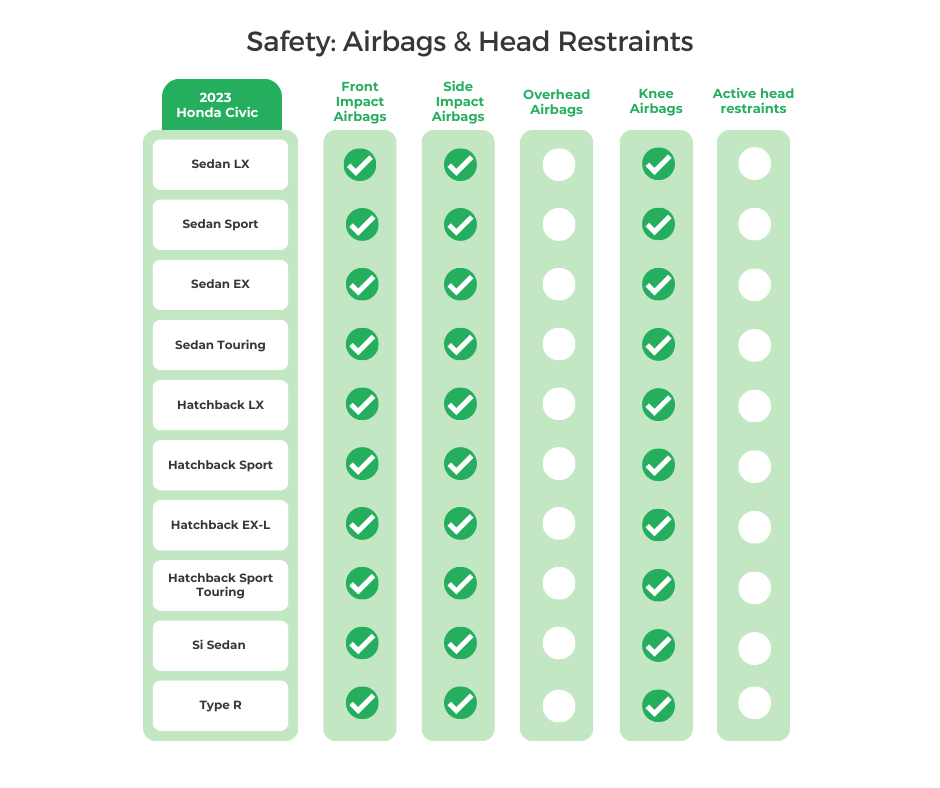
Semi-Autonomous Driving:
While Honda gets praise for many things, its approach to cutting-edge technology is not one of them. You won’t see an Accord or Civic (or any other Honda) with hands-free driving like what’s offered by Tesla, Mercedes-Benz, Ford, General Motors, or other automakers. Honda is more conservative with its introduction of driver-assist features.
The Accord and Civic still have numerous advanced technologies that help keep drivers and their passengers safer. To Honda’s credit, all trims include adaptive cruise control (ACC). ACC uses sensors to detect the speed and distance of vehicles ahead. It automatically adjusts the car’s speed to maintain a safe following distance from a vehicle in the front. These systems minimize the never-ending braking and accelerating that accompanies stop-and-go traffic. However, drivers must keep their hands on the wheel and stay alert when ACC is used.
Both models also get lane-keeping assist technology and road departure mitigation that keeps 2023 Accords and Civics correctly centered in the lane. The driver will receive a visual alert and subtle steering wheel vibration to signal that the car isn’t positioned properly.
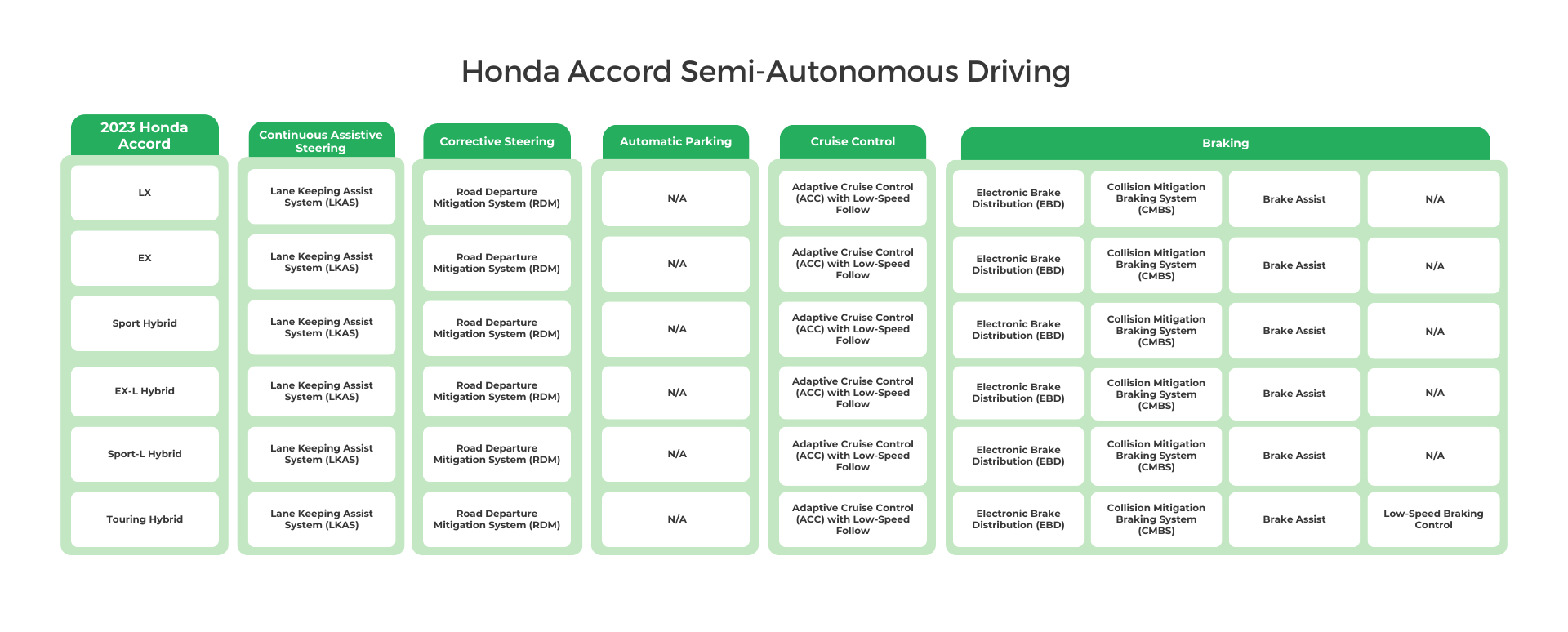
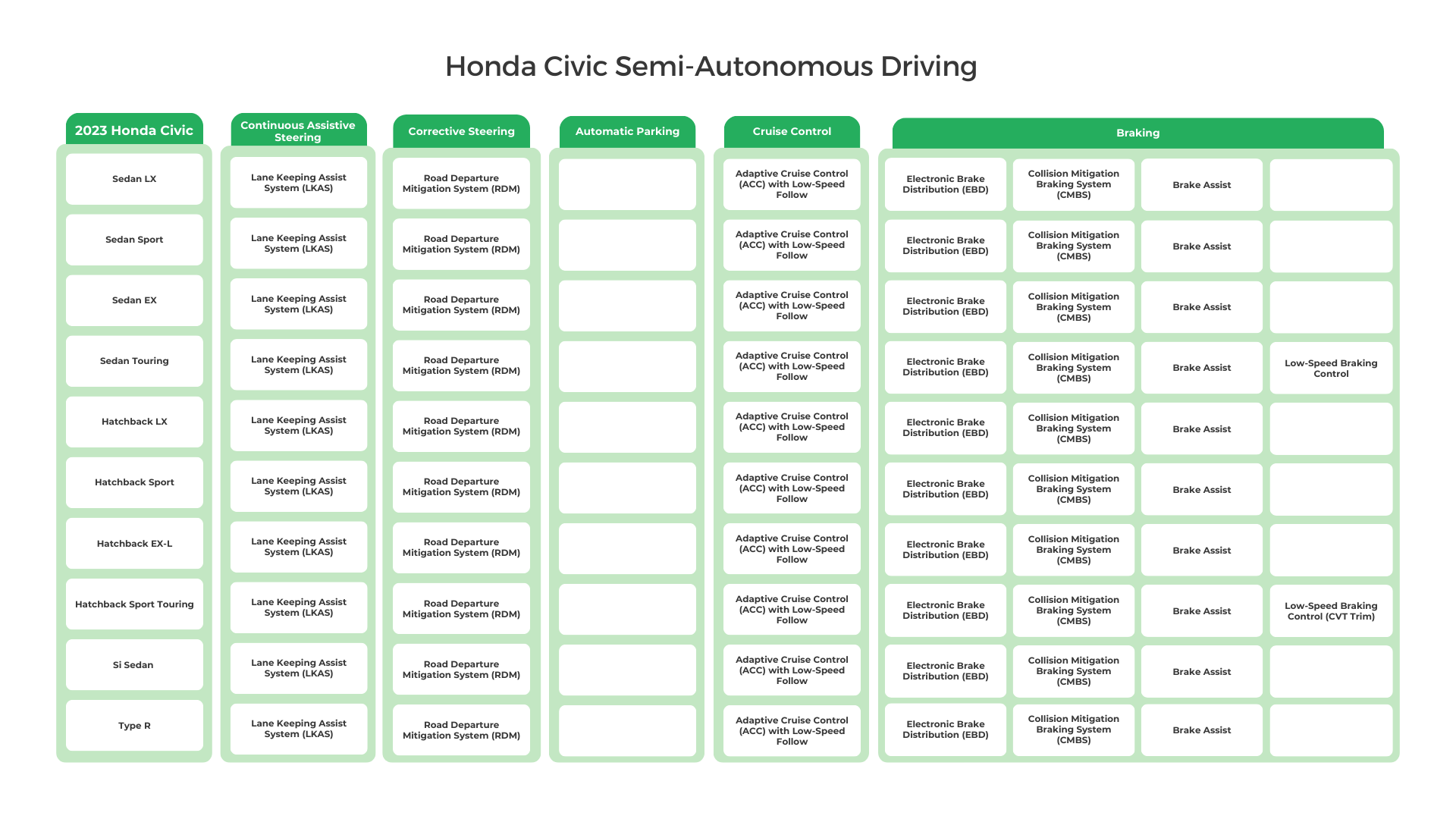
Driver Warning Systems & Telematics:
Honda bundles its advanced driver assistance systems (ADAS) under the Honda Sensing moniker. All Accords and Civics come with forward collision warning (FCW), lane departure warning (LDW), and collision mitigation braking (which is the automaker’s fancy term for automatic emergency braking).
But buyers looking for blind-spot monitoring (BSM) and rear cross-traffic alert (RCTA) must shop carefully. These technologies aren’t available on base Accord and Civic trims. Plus, these ADAS upgrades are optional only on the other Accords. However, these same systems are either standard or optional on the other Civics (it depends on the trim). Confusing? Yes.
While the Accord and Civic (all trims) get a driver attention monitor, only the Accord comes with a rear seat occupant alert.
If ADAS technology appears like alphabet soup, check out an effort from AAA, Consumer Reports, J.D. Power, and other groups working to standardize the terminology for these systems.


Road Visibility Features:
Honda’s approach to road visibility features is straightforward. All Accords and Civics come with LED headlights and automatic high beams. These features are becoming standard on more and more cars, so the automaker is keeping up with the competition. A backup camera is standard, too. But this equipment is required by federal law.
The only out-of-the-ordinary feature is a head-up display (HUD) exclusive to the top-dog Accord Touring Hybrid. A HUD system projects vital driving details (like speed or navigation instructions) onto the windshield, minimizing the driver’s need to look at the instrument cluster or infotainment screen.
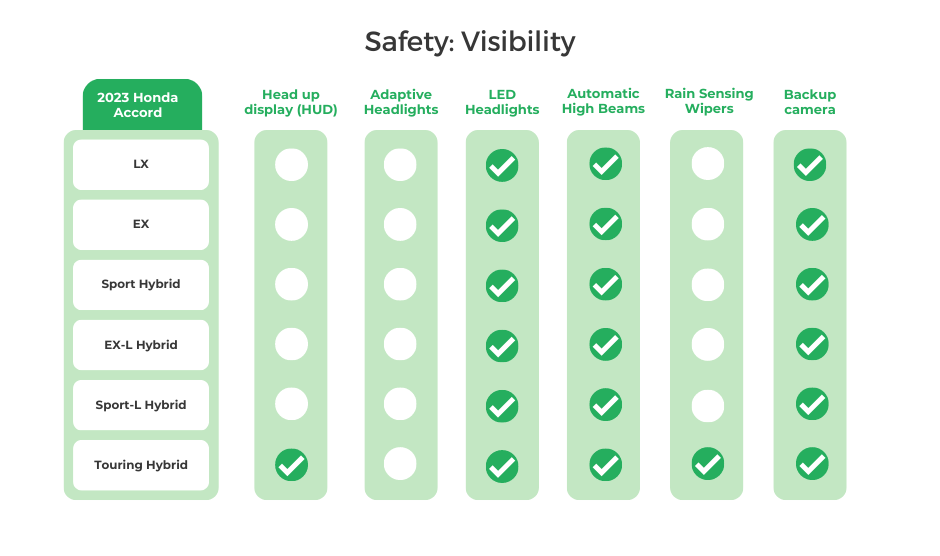
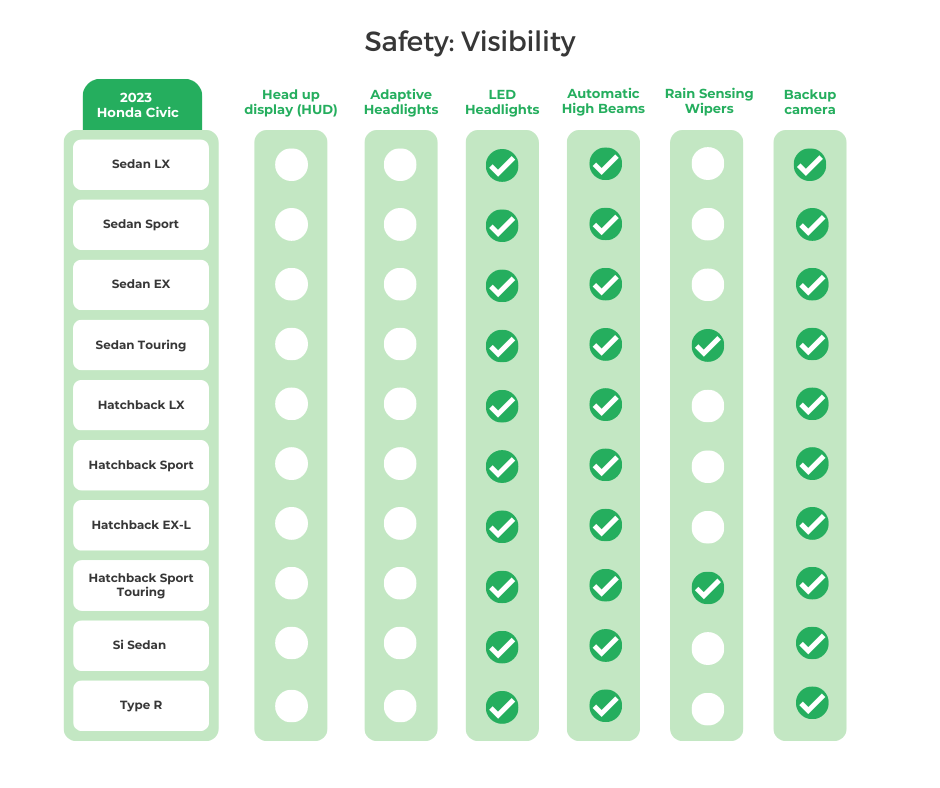
Interior:
Interior Features:
Those who can’t live without their cell phones will take comfort in knowing that Apple CarPlay and Android Auto are included with every 2023 Accord and Civic.
If staying warm and toasty is also important, then knowing which trim gets heated front seats is vital. The LX and Sport versions of the Accord and Civic aren’t available with this equipment. Otherwise, heated front seats are standard on the mid-tier and premium trims.
And speaking of heated seats, some automakers offer this feature through a subscription service. This hasn’t yet happened in the U.S., but in certain countries, BMW offered heated seats for a monthly fee. The advantage is you can shut off the service during warm months, but you’ll need to keep paying (or pay a one-time upfront fee) to activate the heated seats. Recently, BMW announced it was backing away from this practice. Moving forward, the automaker will only charge a subscription for software-based services (like upgraded navigation). Hardware-based features will be part of the vehicle’s initial purchase price.
One industry study shows mixed results for consumer acceptance of features on demand (FoD), with about one-fifth not even being aware of the concept.
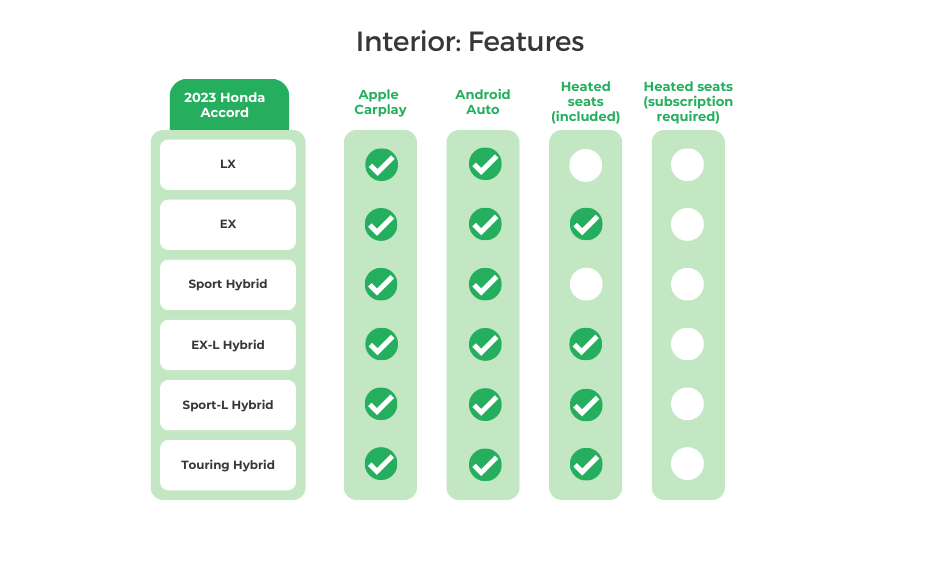
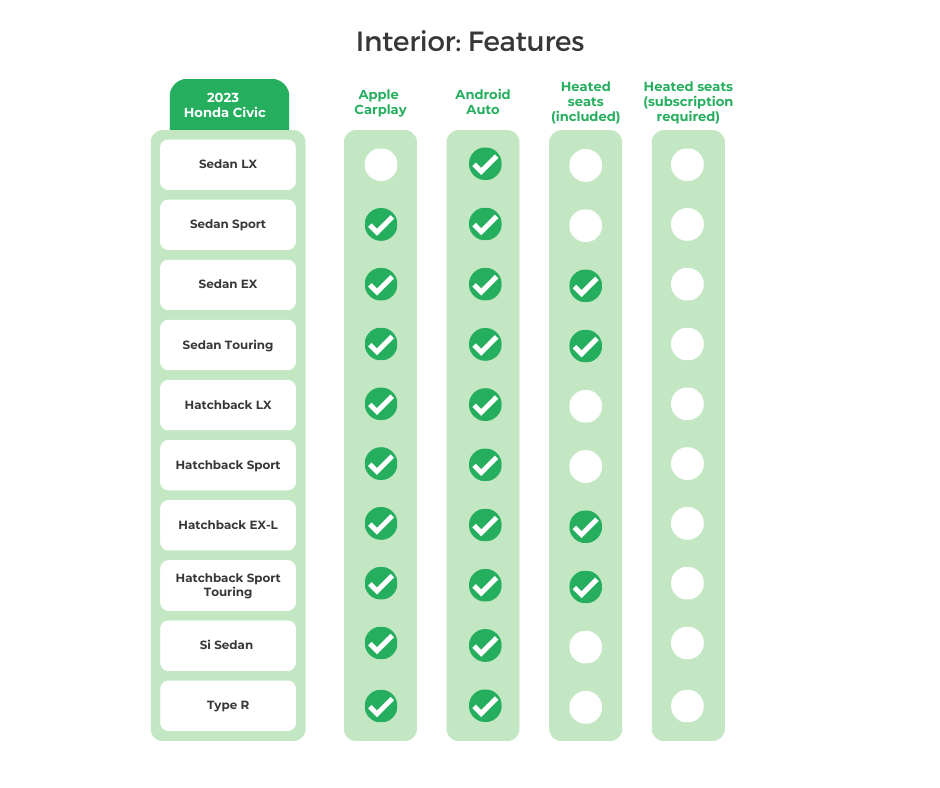
Interior Dimensions:
As covered, the Accord and Civic are classified as mid-size sedans by the EPA, with the Accord having modestly more interior space. Yet there are some surprises. In particular, both vehicles have the same front legroom (42.3 inches), near-identical front headroom (varies by trim), and similar rear headroom (the Accord excels by less than an inch).
Where does the Accord come out on top? Mainly in the back seat. Honda’s largest sedan has 40.8 inches of rear legroom compared to 37.4 inches for its smaller stable mate. There’s an even larger gap with the rear hip room: 55.4 inches for the Accord and 48.9 inches for the Civic. There’s a strong case for the Accord if you regularly pack the second row.
At the same time, the Accord’s larger trunk (16.7 cubic feet) offers greater flexibility than the 14.4-14.8 cubic feet found in the Civic Sedan. Still, if hauling things is more of a priority, the 24.5 cubic feet in the Civic Hatchback’s cargo area can’t be beaten.
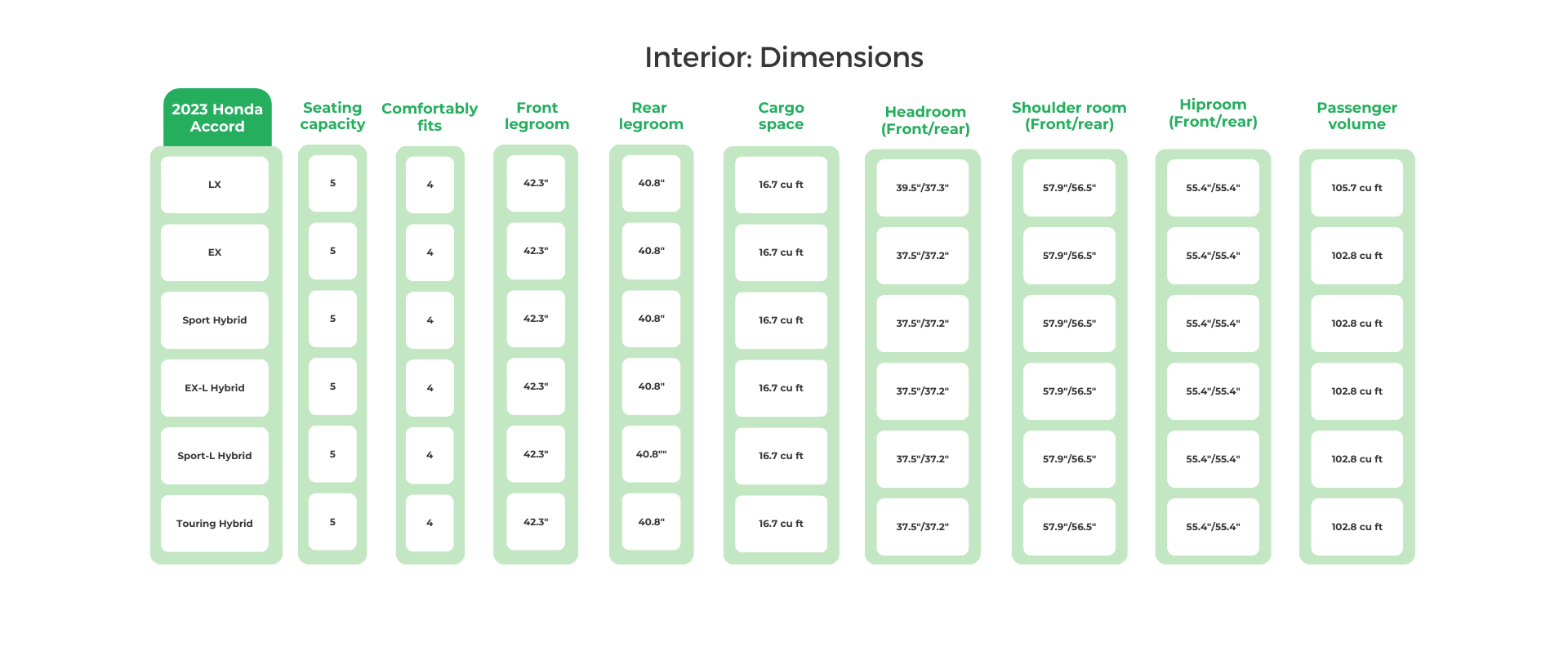
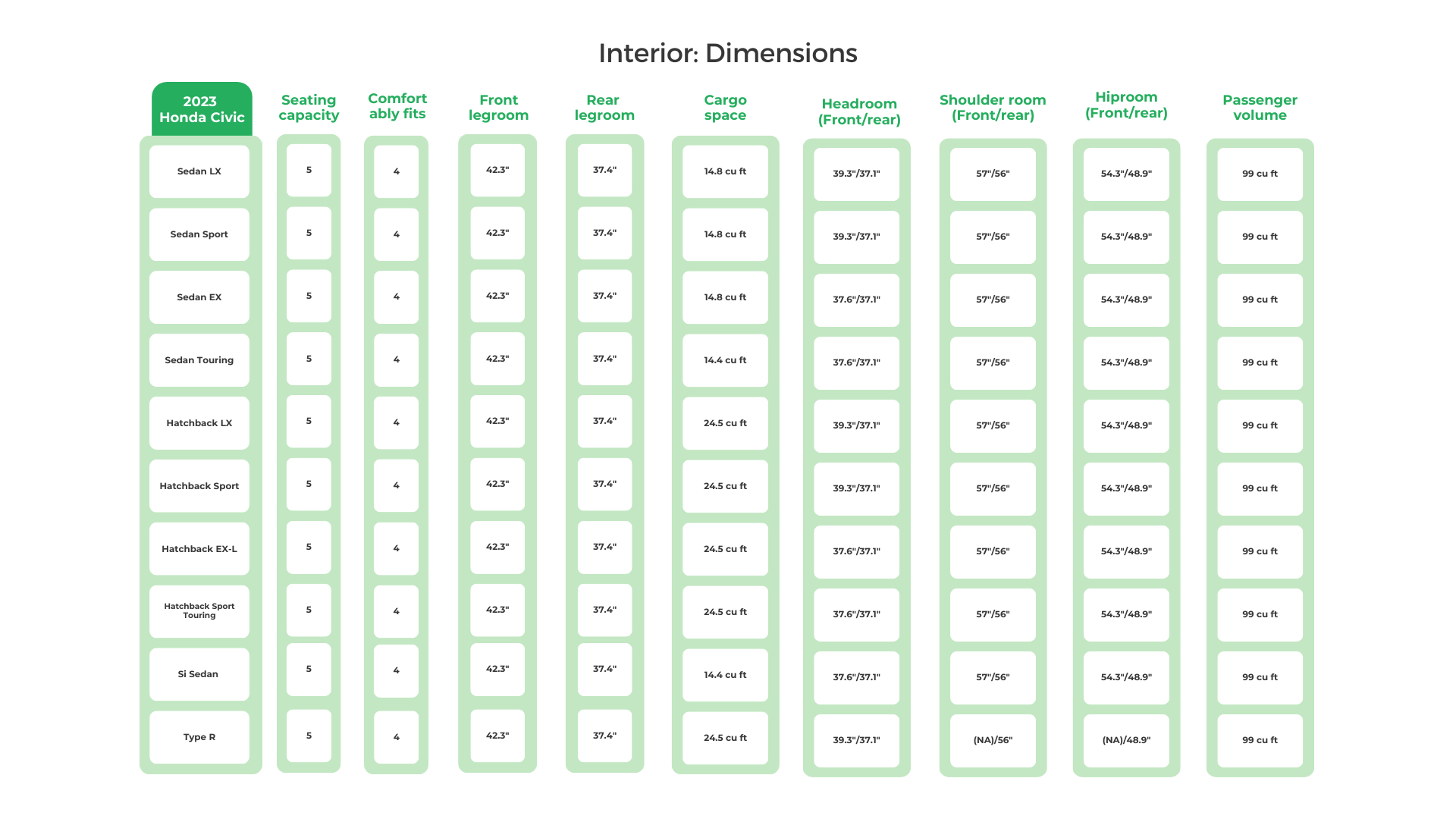
Exterior:
Exterior Features:
Wheels may also be an afterthought for many car buyers. But wheel size can impact ride quality. Larger rims can translate into better traction and cornering but may result in a bumpier ride. Bigger wheels also offer better aesthetics by filling out the wheel wells more completely. This is why the higher the trim, the larger the wheel. Different materials (steel or alloy) and finishes also help separate the wheels among the various trim levels.
Both the Accord and Civic have their share of white, gray, black, and silver exterior paint choices. Yet a look at the brighter tones reinforces how Honda positions these cars. Some Accord trims come in Radiant Red Metallic or Still Night Pearl (a medium blue); these are subdued shades for buyers wanting a modest splash of color, but nothing overstated.
In contrast, select Civic trims are available in Rallye Red or Aegean Blue Metallic. These are eye-popping offerings better suited to a more youthful consumer. Honda goes one step further with the Type R. Along with the usual palette of monotone offerings and Rallye Red, this hot hatch can be painted in Boost Blue Pearl, a head-turning color, for sure.
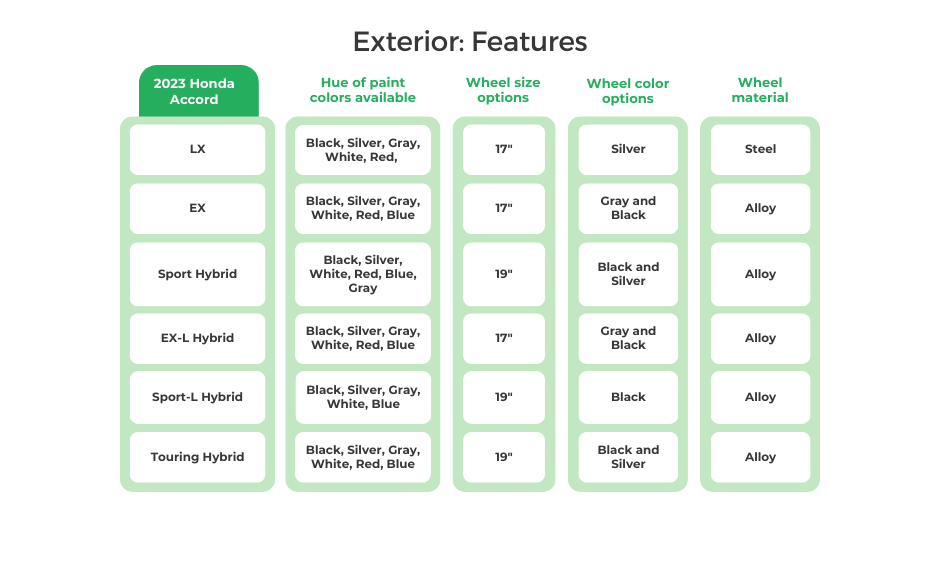

Exterior Dimensions:
One area where the Accord dominates the Civic is exterior size. This may not matter to those in the suburbs, but the extra proportions can matter to city dwellers or owners who park in commercial garages and other tight spaces.
The Accord’s 195.7-inch length easily tops the Civic Sedan (184 inches) and Civic Hatchback (179 inches). Likewise, there’s a difference in width, 73.3 inches for the Accord and 70.9 inches for the Civic (the Civic Type R has a 74.4-inch width due to extra body cladding).
The Accord’s longer wheelbase (111.4 inches versus 107.7 inches for the Civic) will make a difference in ride comfort. A longer wheelbase smooths out rough road surfaces (like highway expansion strips), ensuring a less jarring experience for passengers.
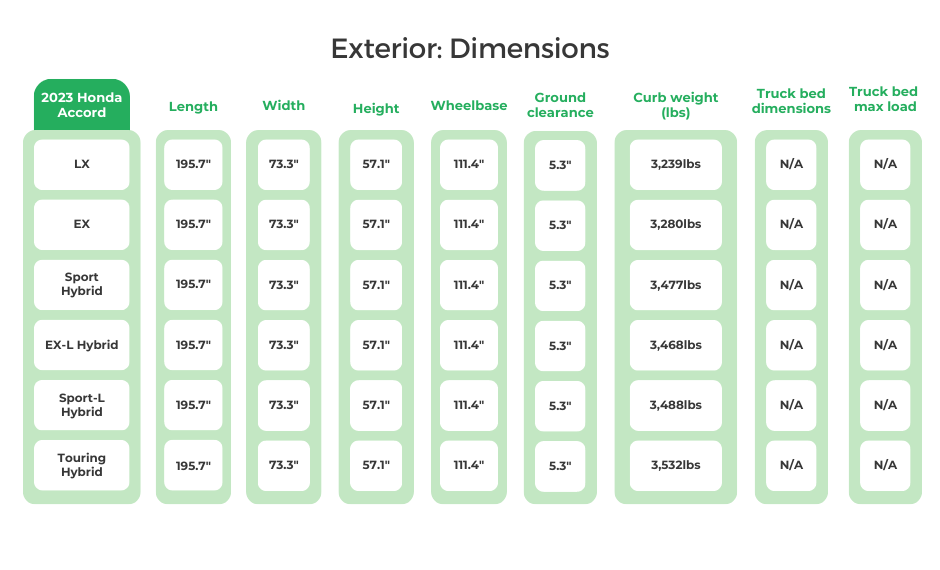
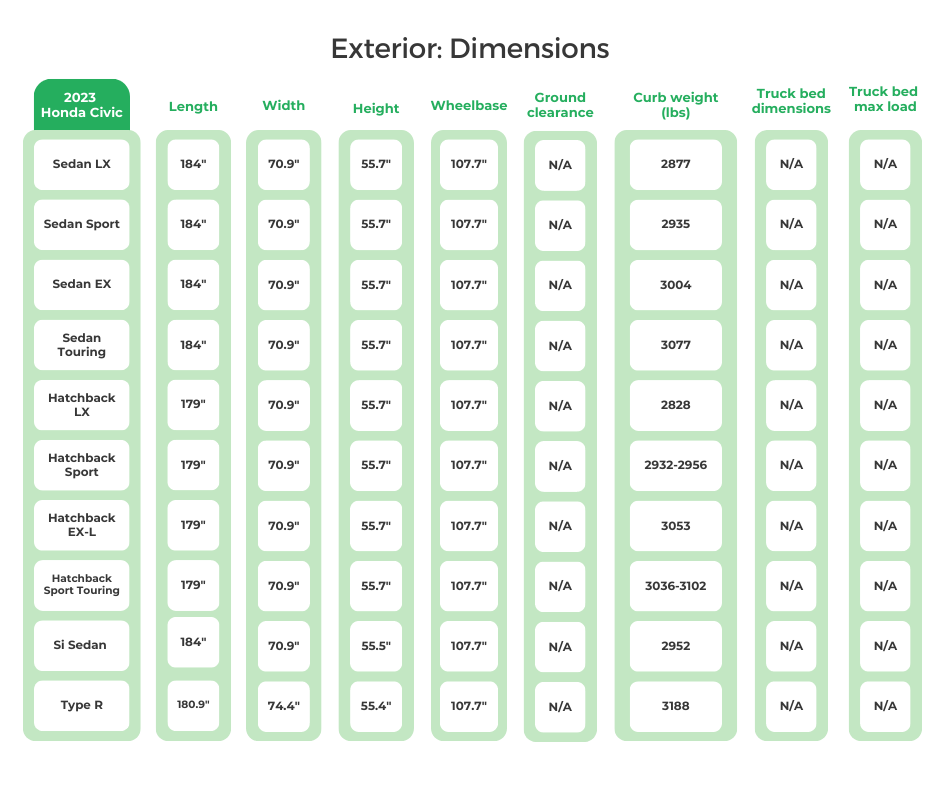
Warranty:
Seeing that Honda sells the Accord and Civic, neither model offers better warranty coverage. Both cars are protected by a three-year or 36,000-mile bumper-to-bumper warranty and five years or 60,000 miles of powertrain safeguards (for the engine, transmission, and drive axle).
| 2023 Honda Accord Factory Warranty Coverage: | 2023 Honda Civic Factory Warranty Coverage: | |
| Basic warranty: | 36 months/36,000 miles | 36 months/36,000 miles |
| Powertrain warranty: | 60 months/60,000 miles | 60 months/60,000 miles |
| Corrosion perforation warranty: | 60 months/unlimited miles | 60 months/unlimited miles |
| Air conditioning warranty: | 24 months/24,000 miles (A/C refrigerant) | 24 months/24,000 miles |
| Battery warranty: | 36 months/36,000 miles | 100 months/unlimited miles |
| Emissions warranty: | Federal: 36 months/36,000 miles California: 36 months/50,000 miles | 36 months/36,000 miles96 months/80,000 miles on some parts |
| Roadside assistance coverage: | 36 months/36,000 miles | 36 months/36,000 miles |
| Total unique recalls: | 0 | 1 |
Driver Experience | A Summary of The Top 10 Honda Accord vs. Honda Civic Reddit Posts:
Reddit has abundant feedback about how the Honda Accord and Honda Civic compare. Here are highlights of some of these conversations from Reddit: r/whatcarshouldIbuy.
Recent Reddit comments indicate the primary differences between the Honda Accord and Honda Civic are size, performance, features, and price. As multiple users pointed out, the Accord tends to be larger and more spacious than the Civic, especially in terms of interior room and legroom for the driver’s seat. One user said, “The Accord has more space in the driver’s seat.” This comment refers to an older model year with more of a front-row difference.
However, other users highlighted the Civic as more “sportier and smaller” and more fuel efficient. One Redditor specifically recommended the Civic over the Accord due to its better gas mileage and higher-tech infotainment system. They stated, “Civic because it is more fuel-efficient and has a better infotainment system.”
Regarding pricing and features, comments indicated the Accord may come more well-equipped in higher trims but at a higher starting price. The Civic was noted to offer more configuration options, with users pointing out the sedan vs. hatchback styles and multiple engine choices. Overall, preferences seemed split between the two models based on individual driving needs and budgets.
Who Should Buy These Cars: The Legacy of The Honda Accord and Honda Civic
Like it or not, the Accord and Civic are primarily commuter and family hauler vehicles with a dose of road-trip usage. Given these tasks, Honda bakes in solid safety scores and very good fuel economy (which is explored in more detail later). In other words, these cars get the job done without drama or fuss.
Data also shows that the Hondas are at least capable of reaching 150,000 miles, while the Accord appears to have better odds of going 200,000 miles.
| Frequent Use Categories: |
Honda Accord | How Useful? (Out of 5 Stars) |
Honda Civic | How Useful? (Out of 5 Stars) |
| Family Vehicle | ***** | **** |
| Lots of Driving (travel/long commute) | **** | ***** |
| Hauling/Towing | * | * |
| Office on Wheels | * | * |
| Sport/Fast Driving | * | * |
| Luxurious Driving | * | * |
| Outdoor/Off-Road | * | * |
Best & Worst Years | Honda Accord vs. Honda Civic | 2001-2024

While the Honda Accord and Honda Civic enjoy overall good reputations for dependability, a look at specific model years says otherwise. This is especially an issue with older Civics. Between the 2001 and 2012 model years, only 2006 and 2010 got a green light. You’ll have more options with an older Accord as the 2004-2007 and 2010-2011 get a thumbs up for reliability. Keep this in mind if you’re looking to buy a cheap Honda.
However, it’s smooth sailing with newer Civics from 2013-2021, as these make the best years list, likewise for the Accord (2014-2021, except for the 2018 edition).
We’ll call attention to the undecided years (yellow) only because there isn’t enough information to give these editions a thumbs up or down.
Important Features Timeline | Honda Accord vs. Honda Civic
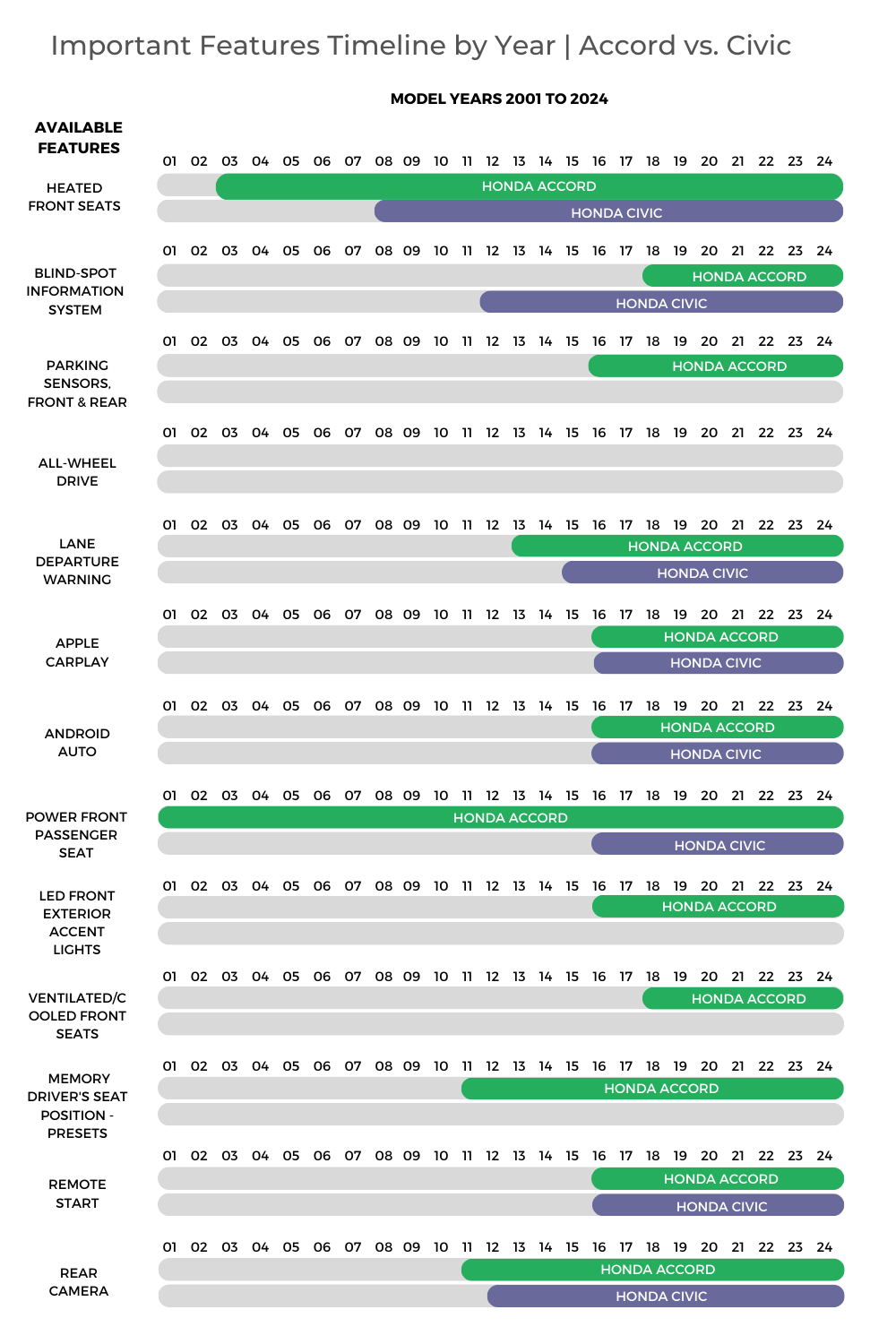
Given that the Accord is positioned as Honda’s flagship sedan, it’s not unusual for this car to receive premium equipment before the Civic.
For instance, comfort and convenience features like heated front seats and a power front passenger seat came to the Accord first. Some equipment (like front and rear parking sensors, ventilated front seats, and a driver’s memory system) have yet to appear in a Civic, further cementing the Accord’s premier status among Honda’s offerings.
However, there are curious exceptions, like the CIvic getting blind-spot monitoring years before the Accord (Honda insisted on sticking with a quirky blind-spot view system in the Accord). Meanwhile, competition helped some features (namely Apple CarPlay, Android Auto, and remote start) come to the Accord and Civic simultaneously.
Maintenance Costs (Year-by-Year Average) | Honda Accord vs. Honda Civic
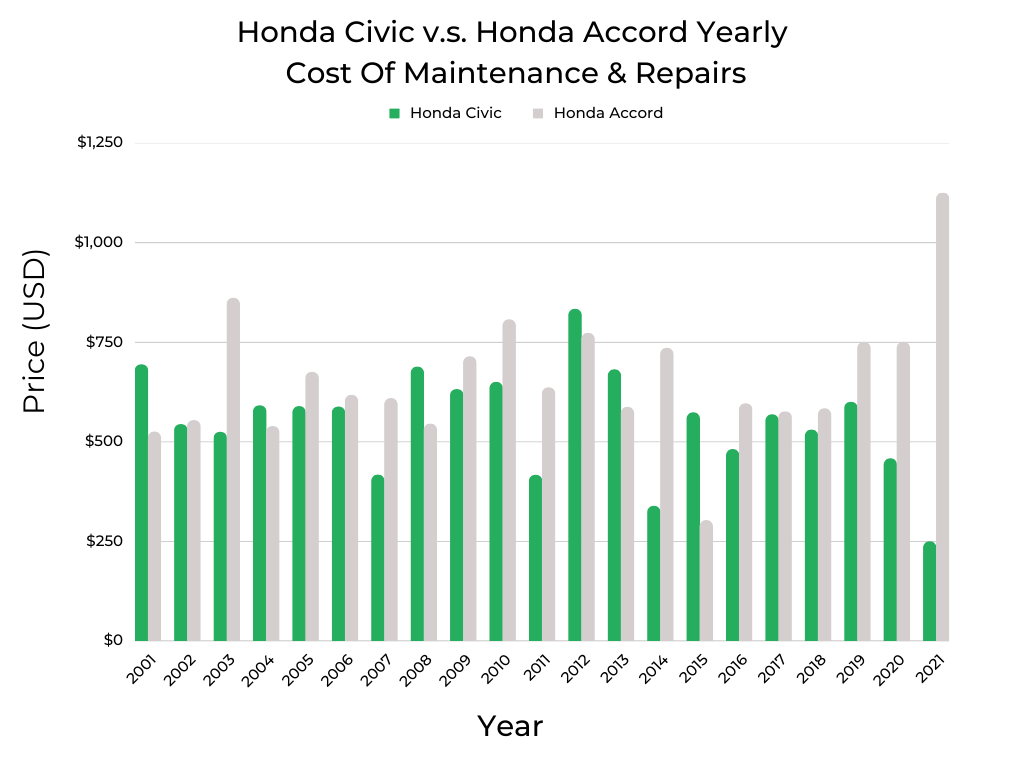
FIXD survey data shows that the average Accord owner spent $660 on maintenance and repairs in 2022. That’s 20% more than the $550 the typical Civic owner incurred.
A look at individual model years shows that most Accord owners stayed under the $660 average or didn’t go far above it. Only with the 2003, 2010, and 2021 model years did owners break the average upkeep barrier by 20% or more. Likewise, there are only a handful of Civic model years (2001, 2008, 2012, and 2013) where owners paid 20% or more than the $550 annual upkeep average.
Like me, you’re probably curious why repair costs are so high for the 2021 Accord. Survey data shows excessive mileage for these cars based on owner reports. It’s fair to say these extraordinary expenses are likely due to brake and tire replenishment.
Overall, repair and maintenance bills for the Accord and Civic are reasonable. Yes, the total is a bit greater for the Accord, but it’s not unusual for a more expensive vehicle’s parts and components to be higher. For instance, the Accord typically uses larger tires, which are costlier.
Upkeep costs are also influenced by maintenance. A diligent approach to regularly servicing a car may involve higher upfront costs but ultimately prevent or delay significant (and expensive) repairs. High mileage is also a contributing factor.
Review the best and worst years of the Honda Accord and Honda Civic to learn more about maintenance and repair costs for these vehicles.
Safety Rating Comparison | Honda Accord vs. Honda Civic
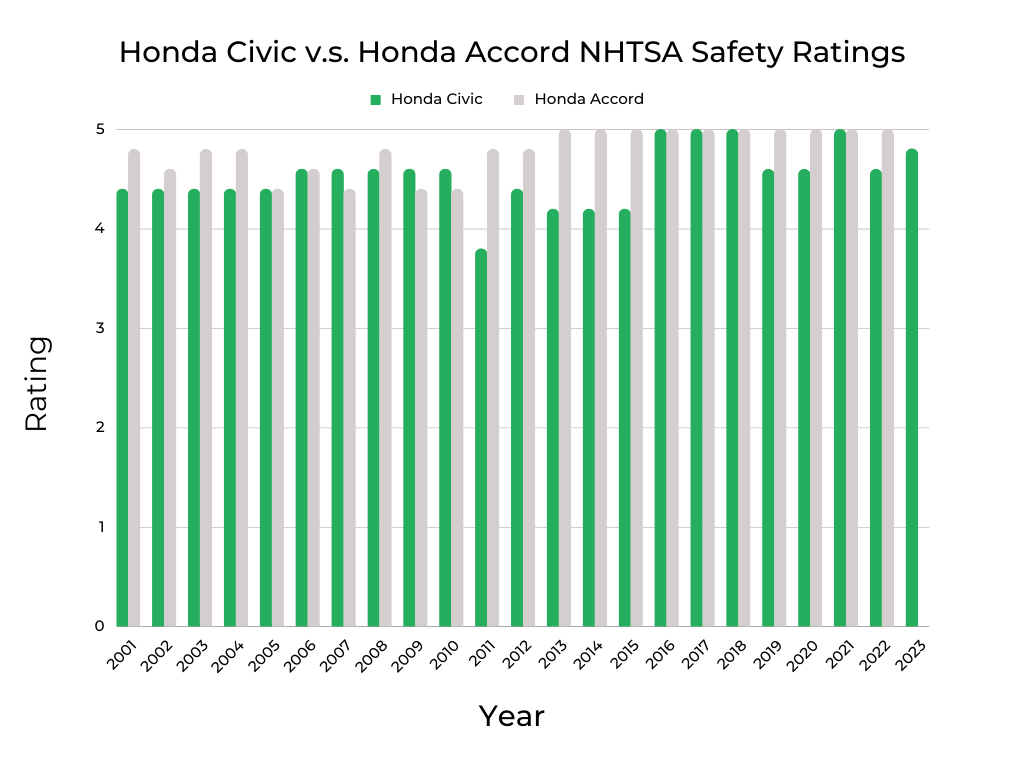
No discussion of family transportation is complete without talking about crash testing and safety scores. Based on the assumption that a score of 4 (out of 5) in NHTSA testing is the minimum benchmark, the Honda Accord and Civic perform quite well (I’ll explain shortly what happened to the Civic in 2011). These are family vehicles, so Honda recognizes that the Accord and Civic have to perform well in safety testing, or sales will suffer.
That said, there are several years where the Accord beats the Civic in these government assessments. For those hyper-focused on safety, this could sway a purchase decision. For example, the 2013 Civic’s overall safety score of 4.25 is commendable, but the 2013 Accord’s 5.0 is perfect. When it comes to safety, you can’t argue with perfection.
I’ll also mention that the government introduced more stringent testing for the 2011 model year. You can see how the Civic responded to these new safety requirements, making it the lowest-performing model year for any 21st-century Accord or Civic. Fortunately, 2012 marked a new Civic generation and improved crash test scores.
More details about crash test safety scores are covered in articles about the Honda Accord and Honda Civic.
Fuel Efficiency Comparison | Honda Accord vs. Honda Civic
If top fuel economy is your priority for buying a conventional gas-powered Honda from the 21st century, look no further than the Civic. Thanks to less powerful engines, a smaller size, and reduced weight, it consistently delivers higher MPGs than any Accord from the same model year. Most of the Accords hover around the 25 MPG mark, while the Civic approaches or crosses the 30 MPG line.
The comparison gets muddy when turning to hybrids because there are so few years where Accord Hybrids and Civic Hybrids overlapped. The earliest Accord Hybrids (2005-2007) never caught on because the extra cost hardly offset the mediocre increase in fuel economy. Yet, older Civic Hybrids (2003-2012) deliver impressive fuel economy. 40 MPG or better is exceptional. Remember, some of these Civics are almost two decades old.
The Accord Hybrid begins to assert its fuel economy dominance as the 2014-2015 model years beat the equivalent Civics. Honda dropped the Civic Hybrid after 2015 but introduced the similarly sized Insight Hybrid based on Civic underpinnings. The Insight lasted from 2019 to 2022 in Honda’s U.S. lineup.
However, since 2017, Honda has put most of its hybrid sedan efforts into the Accord. Fuel efficiency in the 45 MPG or better range is remarkable for a vehicle of this size.
Methodology
- Compare two vehicles, Honda Accord and Honda Civic, and provide a comprehensive analysis.
- Gather relevant information and data on both vehicles from reliable sources, such as manufacturer specifications, expert reviews, customer feedback, industry reports, and data sources like manufacturer websites, FIXD App, Kelley Blue Book, FuelEconomy.gov, and NHTSA.
- Collect data on various aspects, including performance, safety features, fuel efficiency, maintenance costs, reliability, owner satisfaction, and market value.
- Identify the key criteria that will be used to evaluate and compare the two vehicles.
- Ensure the criteria cover both objective factors (such as performance metrics, safety ratings, and fuel efficiency) and subjective factors (such as owner satisfaction, comfort, and features).
- Assess the performance of both vehicles based on factors such as acceleration, handling, braking, and overall driving experience.
- Compare engine options, horsepower, torque, transmission options, and any unique performance features.
- Examine the safety features and ratings of both vehicles.
- Evaluate crash test ratings, advanced driver assistance systems (ADAS), active and passive safety features, and any notable recalls or known issues related to safety.
- Consider both NHTSA safety ratings and IIHS awards for a comprehensive safety assessment.
- Analyze the fuel economy of both vehicles based on EPA mileage estimates.
- Compare their MPG ratings, average full-tank range, and any significant differences in fuel efficiency.
- Assess the average annual maintenance and repair costs for both vehicles.
- Consider data from surveyed owners and other reliable sources, such as FIXD App owner surveys, to determine the overall cost of ownership over time.
- Evaluate the reliability of both vehicles based on owner reports, FIXD App data, and any known issues or recalls.
- Consider factors such as engine reliability, common problems by model year, long-term durability, and owner reliability scores gathered from surveys.
- Consider owner satisfaction by gathering information from forums, online communities (Reddit: r/whatcarshouldIbuy), customer reviews, and owner reliability scores.
- Summarize key factors that owners appreciate and any common complaints or drawbacks mentioned by owners.
- Compare the features and technologies offered by both vehicles.
- Highlight any notable differences in terms of infotainment systems, connectivity options, driver assistance features, interior quality, and available upgrades.
- Assess the market value and depreciation of both vehicles.
- Compare average prices, resale value, and how the vehicles hold their value over time.
- Consider average private-seller valuations from Kelley Blue Book (KBB) for a comprehensive assessment.
- Summarize the findings of the comparison, highlighting the positives and negatives of each vehicle.
- Provide a fair and balanced recommendation based on the comparison, considering factors such as budget, personal preferences, specific needs of the buyer, and the comprehensive analysis conducted.
Sources:
- KBB Values: Average private-seller valuations as supplied by Kelley Blue Book (KBB), based on a Honda Accord and Honda Civic with typical mileage for that respective model year.
- Fuel Economy: Mileage-per-gallon estimates according to the EPA MPG on Fueleconomy.gov.
- Annual Maintenance/Repairs: Upkeep expenses as reported by surveyed Honda Accord and Honda Civic owners.
- Safety Ratings: Crash test data collected and reported by NHTSA. We average all ratings for each year to come up with a simplified, average safety score. This makes it easier to look at on a graph. We also collected IIHS Awards for this article.
- Vehicle Features: Most or all information gathered on vehicle features was from the manufacturer’s website, in this case, hondacars.com.

Dave Goldberg is an automotive journalist and lifelong car fanatic. He writes for numerous enthusiast and business outlets and is an ongoing contributor to HotCars.com, one of the most popular car culture websites. When he’s not writing or driving, Dave is either under a hood or asleep. His credentials include a BA in Journalism from The George Washington University.

